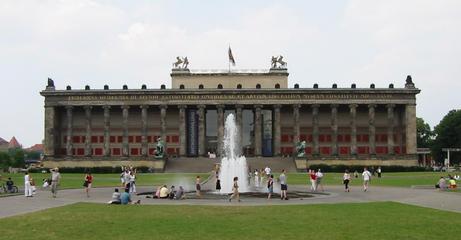<Back to Index>
- Natural Philosopher John Theophilus Desaguliers, 1683
- Architect Karl Friedrich Schinkel, 1781
- Prime Minister of the United Kingdom Charles Grey, 2nd Earl Grey, 1764
Karl Friedrich Schinkel (13 March 1781 – 9 October 1841) was a Prussian architect and painter. Schinkel was one of the most prominent German architects and the best example of neoclassicism.
Schinkel was born in Neuruppin in the Margraviate of Brandenburg. He lost his father at the age of six in Neuruppin's disastrous fire. He became a student of Friedrich Gilly (1772–1800) and his father, David Gilly, in Berlin. After returning to Berlin from his first trip to Italy in 1805, he started to earn his living as a painter. Working for the stage he created a star-spangled backdrop for the appearance of the "Königin der Nacht" in Wolfgang Amadeus Mozart's opera The Magic Flute, which is even quoted in modern productions of this perennial piece. When he saw Caspar David Friedrich's painting Wanderer above the Sea of Fog at the 1810 Berlin art exhibition he decided that he would never reach such mastery of painting and definitely turned to architecture. After Napoleon's defeat, Schinkel oversaw the Prussian Building Commission. In this position, he was not only responsible for reshaping the still relatively unspectacular city of Berlin into a representative capital for Prussia, but also oversaw projects in the expanded Prussian territories spanning from the Rhineland in the West to Königsberg in the East.
Between 1808 and 1817 Schinkel renovated and reconstructed Schloss Rosenau, Coburg, in the Gothic Revival style.
Schinkel's
style, in his most productive period, is defined by a turn to Greek
rather than Imperial Roman architecture, an attempt to turn away from
the style that was linked to the recent French occupiers. (Thus, he is
a noted proponent of the Greek Revival.) His most famous buildings are found in and around Berlin. These include Neue Wache (1816–1818), the Schauspielhaus (1819–1821) at the Gendarmenmarkt, which replaced the earlier theater that was destroyed by fire in 1817, and the Altes Museum (old museum) on Museum Island (1823–1830). Later, Schinkel would move away from classicism altogether, embracing the Neo-Gothic in his Friedrichswerder Church (1824–1831). Schinkel's Bauakademie (1832–1836),
his most innovative building of all, eschewed historicist conventions
and seemed to point the way to a clean-lined "modernist" architecture
that would become prominent in Germany only toward the beginning of the
20th century. Schinkel,
however, is noted as much for his theoretical work and his
architectural drafts as for the relatively few buildings that were
actually executed to his designs. Some of his merits are best shown in
his unexecuted plans for the transformation of the Athenian Acropolis into a royal palace for the new Kingdom of Greece and for the erection of the Orianda Palace in the Crimea. These and other designs may be studied in his Sammlung architektonischer Entwürfe (1820–1837) and his Werke der höheren Baukunst (1840–1842; 1845–1846). He also designed the famed Iron Cross medal of Prussia, and later Germany. It
has been speculated, however, that due to the difficult political
circumstances – French occupation and the dependency on the Prussian
king – and his relatively early death, which prevented him from seeing
the explosive German industrialization in the second half of the 19th
century, he did not even live up to the true potential exhibited by his
sketches.
